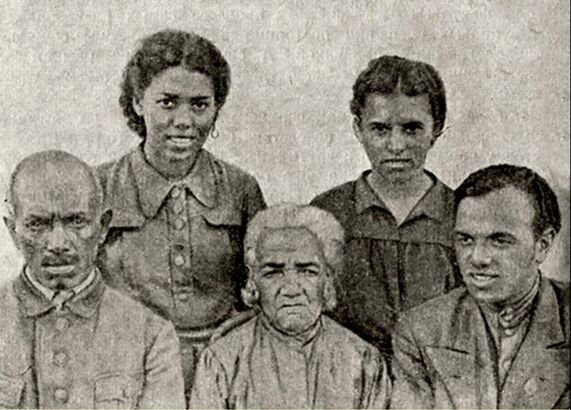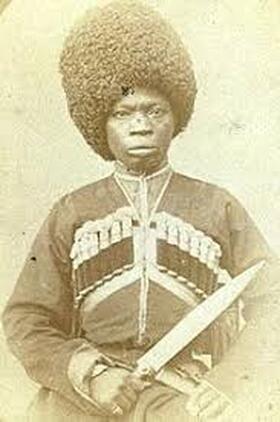|
A Spanish slave ship traveling the Magdalena River in Columbia was wrecked allowing the slaves aboard to escape, one of the slaves who escaped was the legendary Benkos Biohó, Bioho was a West African of royal descent. Bioho and his comrades escaped into the Columbian mountains, settling and establishing what is now San Basilio de Palenque around 1603. Located at the bottom of the Montes de Maria Mountain in the Bolivar Department of the country of Columbia, near the city of Cartagena, sits the historical African settlement that still stands to this day. The word Palenque translates to “walled city”. The freed Africans who established the Palenque were known to frequently raid the slave plantations of Cartagena freeing a large number of slaves. Cartagena at the time was used as a main slave-trading location in Columbia. The Palenque was well hidden which allowed it to not be found by the Spanish surviving for over two-hundred years. The inhabitants of San Basilio de Palenque are referred to as Palenqueros. The isolation of the Palenqueros over the centuries allowed them to preserve their African culture while infusing it with Spanish culture. The Palenqueros speak a form of creole called Palenquero, a language this is widely believed to be the only Spanish-based creole language spoken in the world. Around 3,500 Palenqueros were established. Between 1691 and 1713, San Basilio de Palenque was issued a Royal Decree by the Spanish declaring them free as long as they stopped raiding the plantations of Cartagena. The women of Palenque are known as the Palenqueras, these women dressed in beautiful bright colored dresses with turban-wrapped heads. The women are masterful saleswomen who are famous for their look and their delicious food. The food of the Palenqueras is widely known and desired across the world. So much so that Palenquera recipes were awarded the Gourmand World Cookbook Award in 2014, and Palenquera recipes have been included in over 15,000 cookbooks throughout the years. African culture influenced by Spanish, Caribbean, and South American cultures is what makes up the culture of San Basilio de Palenque, a settlement that is documented as the first free African settlement in the Americas. Their music, food, fashion, language, dances, and ways of thinking are based on their ancestral heritage, a heritage that was untouched by the Spanish for over two-hundred years. The Palenquero people were able to establish a way of living that was unique to them as well as empowering. From the time of the legend Benkos Bioho to the present day, San Basilio de Palenque stands as a symbol of African resistance, African pride, African strength, and African freedom. To Benkos Bhiho and the many heroes who established the Palenque and the inhabitants of San Basilio de Palenque, we proudly stand on your shoulders. J. A. Ward Click here to learn more about the On the Shoulders of Giants book series!! References:
https://ich.unesco.org/en/RL/cultural-space-of-palenque-de-san-basilio-00102 https://www.colombia.co/en/colombia-country/environment/caribbean-region/san-basilio-de-palenque-first-free-town-africans-americas/ https://impulsetravel.co/tour-operator/en/blog/93/san-basilio-de-palenque-a-historical-day-trip-dentination-from-cartagena https://en.wikipedia.org/wiki/San_Basilio_de_Palenque
0 Comments
Before the founding of the Asante Empire, the Asante was a part of an Akan ethnic group that eventually became divided over time. What caused the division is debated, but whatever the truth is, it helped to lead to the unification of the Asante Empire. Migrations of the early Asante people led them settling along the coast of modern-day Ghana, the location they chose was rich in gold, kola nuts, and other natural resources; it was also a prosperous trade route. The Asante had not yet become a powerhouse, the Denkyira were the dominant Asante state; the Asante king at the time Obiri Yeboa had plans to become the dominant Asante state and eventually unify the Asante states. Obiri Yeoba was the Asante King from sixteen-sixty until sixteen-eighty. Little did Obiri Yeboa know his nephew Osei Tutu would bring his dream to life. Osei Tutu became the King of the Asante in sixteen-eighty, succeeding his uncle Obiri Yeboa, Tutu along with his priest Okomfo Anokye prepared to carry out their plans to unify the Asante. As stated previously, the Denkyira was the dominate Asante group and the main adversary for Tutu to conquer. Before Tutu made his move against the Denkyira, he united the other Asante clans he was named the Asantehene or King of the Asante, and united the remaining Asante clans under the Asantehene. Tutu also became the first Asantehene to have the Golden Stool. It is said that during a meeting between Tutu and the other Asante chiefs, Tutu's priest Okomfo Anokye summoned a golden stool from the heaven that landed in Osei Tutu’s lap. The Asante chiefs pledged their allegiance to the Asante, the golden stool, and Osei Tutu. The next step for Tutu was to defeat the Denkyira and unite the Asante kingdom. Okomfo Anokye along with his magic helped to decide the location of the Asante capital. Okomfo Anokye planted two trees, one at Kumasi and one at Kumawu, Kumasi became the Asante capital because the tree planted there grew tall and strong, the tree at Kumawu died. The cities of Jenne and Timbuktu were very important to the trade routes flowing through the Asante occupied area of Ghana. Whoever controlled the Asante clans controlled the trade routes. When Kumasi became the capital of the Asante states Tutu gained the title of Kumasihene along with his title as Asantehene during the first Odwira Festival, which is an annual festival to celebrate the unification of the Asante states. Tutu along with Okomfo Anokye and other Asante leaders created a constitution and a confederacy to govern the unified Asante states, it was also expressed that Tutu held the power of Chief of the Asante and the Chief Priest. Osei Tutu had one very critical mission; to achieve his goal defeating the Denkyira was a must. Tutu organized a strong military force to protect his unified Asante state, he also used his military to expand into the Asante Empire. Tutu eventually went to war against the Denkyira and defeated them, he also defeated other opposing states, the defeated Asante states along with the Denkyira became a part of the now unified Asante Empire. The empire was officially unified under Osei Tutu in the year 1701; under his leadership, the Asante Kingdom flourished, expanding economically, geographically, politically, and militarily. The Asante Empire became one of the most legendary empires in the history of the world. Tutu led the Asante Empire until his death in 1717 during a battle against the Akyem. The Asante Empire continued to flourish even after Tutu’s death, Opoku Ware succeeded Tutu and strengthened the unity if the Asante Empire by creating the Great Oath of the Asante. The empire continued its reign until it fell to the British invaders in the year 1900. To the great Asantehene Osei Kofi Tutu I, we proudly stand on your shoulders. J.A. Ward Click here to learn more about the On the Shoulders of Giants book series!!! References:
https://en.wikipedia.org/wiki/Osei_Kofi_Tutu_I https://www.blackpast.org/global-african-history/tutu-osei-kofi-c-1680-1717/ http://en.lisapoyakama.org/osei-tutu-the-founder-of-the-asante-empire/ https://www.ghanaweb.com/GhanaHomePage/history/ashanti.php https://www.culturesofwestafrica.com/history-ashanti-empire-colonization/ https://en.wikipedia.org/wiki/List_of_rulers_of_Asante https://ghananation.com/rulers/?blurb=403 The origins of humanity and civilization can be traced back to the Nile Valley in Africa starting around Uganda and South Sudan flowing to Egypt. The African diaspora is the term used to describe the many African people who traveled out of Africa and populated the world. As far as we know, African people have inhabited every continent and left information about their cultures and ways of living across various lands. The Caucuses are no exception, Africans inhabit the Caucuses, and I will tell you about one group of African people called the Abkhazians who have lived in the caucuses for centuries. From my research, I have found a few stories that explain the origins of the Abkhazians, those stories are as follows. The Abkhazians inhabit the sovereign state of Abkhazia located along the northeastern coast of the Black Sea in the Republic of Georgia. According to accounts by the historian Herodotus, during the fifth century BC he traveled throughout the Caucuses and learned about a group of African people called the Colchians who lived in the area known then as Colchis. He described them as a Negro people with black skin and woolly hair who practiced circumcisions; Herodotus stated that the only people he knew that practiced circumcisions were Egyptians and Ethiopians. He also noticed that the Colchians practiced weaving patterns that originated in Egypt. Herodotus conducted research and concluded that the Colchians were Egyptians that were a part of the Army of the Pharaoh Sesostris after his campaign in southern Russia. An American journalist named John Gunther, centuries after Herodotus, also traveled to Colchis and learned that black people of African descent inhabit the lands, but was told that they existed in the region due to their ancestors being slaves of the Turkish. According to J. Malte-Brun, Colchis was a place that was constantly raided by slaveholders, Malte-Brun also concluded that it was unlikely that the Colchians were imported into the regions by the Turkish slaveholders. The Abkhazians are descendants of the Colchians as documented by the Russian writer Maxim Gorky, who sat with the elders of an Abkhazian village as the elders told Gorky about their heritage, and from those meetings, he concluded that the origins of the Abkhazians trace back through the Colchians from Egypt and Ethiopia. One hypothesis that exists about the origins of the Abkhazians is that they were Moors who were a part of the Roman Empire who often explored Eurasia. Another Theory Is that they are an indigenous European group called the Nigiri Latinis who inhabited European lands from Spain to Russia. However, a number of European historians agree on the hypothesis that the Abkhazians who inhabit Abkhazia today were brought there as slaves by the Ottoman Empire, or by the Georgian ruling family of Abkhazia the Shervashidzes. One European story tells of an Ottoman shipwreck carrying slaves and the slaves who survived the shipwreck became the Abkhazians. The Narts Sagas which are a series of stories about the origins of the people of the North Caucuses states that African people from the Horn of Africa were “escorting” the Narts on their travels throughout the Caucuses. One of the last pieces of information that European historians use to prove their slave history theory of the Abkhazians is a letter by Ivan Isakov to a man named Khrushchev stating that Afro-Abkhazians escorted Illarion Vorontsov-Dashkov as he traveled into the region of Abkhazia. The issue with the European accounts about the Abkhazian origins is that none of the Abkhazian people or historians validates their stories. The verified stories of the Abkhazian origins are more aligned with the findings and conclusions of Herodotus and the European historians that agree with him. What we do know is that once again African people can be found around the globe inhabiting lands that are thought to not have any Africans present. To the Abkhazian people and the African diaspora, we stand on your shoulders. J.A. Ward Click here to learn more about the On the Shoulders of Giants book series!!! References:
https://www.georgianjournal.ge/discover-georgia/29876-the-tale-of-afro-abkhazians.html https://en.wikipedia.org/wiki/Abkhazians_of_African_descent https://www.africaresource.com/rasta/sesostris-the-great-the-egyptian-hercules/the-moors-of-abkhazia/The https://face2faceafrica.com/article/the-little-known-story-of-the-african-caucasians-enslaved-in-russia-in-the-17th-century https://www.africaresource.com/rasta/wp-content/uploads/2010/09/abkhazia-blakks.gif https://www.britannica.com/place/Abkhazia |
Details
Categories
All
Click Here to join our mailing list
|
Contact Us: |
Connect With Us |
Site powered by PIT Web Design






 RSS Feed
RSS Feed



